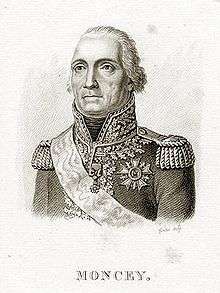Bon-Adrien Jeannot de Moncey
.jpg)

Bon-Adrien Jeannot de Moncey (or Jannot de Moncey), 1st Duke of Conegliano, 1st Baron of Conegliano, Peer of France (31 July 1754 – 20 April 1842), Marshal of France, was a prominent soldier in the Revolutionary and Napoleonic Wars. MONCEY is one of the Names inscribed under the Arc de Triomphe, on Column 33.
Biography
He was born on 31 July 1754 in Palise or Moncey, Doubs. His father was a lawyer from Besançon. In his boyhood he twice enlisted in the French army, but his father procured his discharge on both occasions. His desire was at last gratified in 1778, when he received a commission. He was a captain when, in 1791, he embraced the principles of the French Revolution. Moncey won great distinction in the campaigns of 1793 and 1794 during the War of the Pyrenees, rising from the commander of a battalion to the commander-in-chief of the Army of the Western Pyrenees in a few months, and his successful operations were largely instrumental in compelling the Spanish government to make peace. After this he was employed in the highest commands until 1799, when the government, suspecting him of Royalist views, dismissed him. From 1801-15 he was inspector general of the police.
The coup d'état of 18 Brumaire in 1799 brought him back to the active list, and in Napoleon's Italian campaign of 1800 he led a corps from Switzerland into Italy, surmounting all the difficulties of bringing horses and guns over the then formidable Gotthard Pass. In 1801, Napoleon made him inspector-general of the French Gendarmerie, and on the assumption of the imperial title created him a Marshal of France. In 1805 Moncey received the grand cordon of the legion of honor.
In July 1808 he was made duke of Conegliano; it was a duché grand-fief, a rare hereditary honor. The title was later confirmed under the Restauration, and, since he had no son, the Marshall was granted permission to pass it to his son-in-law (with his newly granted title of Baron of Conegliano and Peer of France).
The same year, the first of the Peninsular War, Moncey was sent to Spain in command of an army corps. He distinguished himself by his victorious advance on Valencia, but the effect of that was destroyed by Dupont's defeat at the Battle of Bailén. Moncey then took a leading part in the emperor's campaign on the Ebro and in the Second Siege of Saragossa in 1809.
He refused to serve in the invasion of Russia, and therefore had no share in the campaign of the Grande Armée in 1812 and 1813. However, when France was invaded in 1814, Marshal Moncey reappeared in the field and fought the last battle for Paris on the heights of Montmartre and at the barrier of Clichy.
In 1814 he supported Louis XVIII and was created a Peer of France as Baron of Conegliano (June 1814, confirmed in 1825). He remained neutral during Napoleon's return, the 'Hundred Days', feeling himself bound to Louis XVIII by his engagements as a Peer of France, but after Waterloo he was punished for refusing to take part in the court martial of Marshal Ney by imprisonment and the loss of his marshalate and peerage.
The King returned his title of Marshal in 1816, and he re-entered the chamber of peers three years later. He continued his military career: his last active service was as commander of an army corps in the short war with Spain in 1823. In 1833 he became governor of the prestigious Hôtel des Invalides (a home for veterans in Paris). Present at the return of Napoleon's ashes in December 1840, he said after the ceremony, "Now, let's go home to die".
He married Charlotte Prospère Remillet (1761 – 1842), by whom he had 3 children:
- Anne-Francoise (1791 – 1842), married to Louis-Charles Bourlon de Chevigné, who was permitted by the King to add "de Moncey" to his surname in 1819.
- Bon-Louis (1792 – 1817)
- Jeanne-Francoise (1807 – 1853), married Alphonse-Auguste Duchesne de Gillevoisin de Conegliano (1798-1878), 2nd Baron de Gillevoisin and later 2nd Duke of Conegliano and 2nd Baron of Conegliano, who inherited his father-in-law's titles.
References
 This article incorporates text from a publication now in the public domain: Chisholm, Hugh, ed. (1911). "article name needed". Encyclopædia Britannica (11th ed.). Cambridge University Press.
This article incorporates text from a publication now in the public domain: Chisholm, Hugh, ed. (1911). "article name needed". Encyclopædia Britannica (11th ed.). Cambridge University Press.- Beckett, Ian F. W. (1987). "Moncey: An Honest Man". In Chandler, David G. Napoleon's Marshals. New York, N.Y.: Macmillan. ISBN 0-02-905930-5.
- Clerget, Charles (1905). Tableaux des Armées Françaises pendant les Guerres de la Révolution (in French). Paris: Librarie Militaire R. Chapelot et Cie. Retrieved 25 July 2015.
| Military offices | ||
|---|---|---|
| Preceded by Jacques Léonard Muller |
Commander-in-chief of the Army of the Western Pyrenees 1 September 1794–12 October 1795 |
Succeeded by disbanded |
| Preceded by Guillaume Brune |
Interim Commander-in-chief of the Army of Italy 8 March–19 June 1801 |
Succeeded by disbanded |
.svg.png)